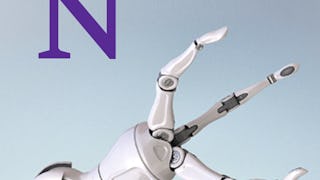Robotics Basic is an introductory course that provides a structured, hands-on overview of industrial robotics. Over 13 compact modules, learners explore the mechanical, electrical, and digital components that make up modern robotic systems.


您将获得的技能
- Human Machine Interfaces
- Automation
- Safety and Security
- Mechanical Design
- Industrial Engineering
- Performance Testing
- Programming Principles
- Safety Standards
- Manufacturing and Production
- Robotic Process Automation
- Manufacturing Standards
- Computer Programming
- Human Factors
- Equipment Design
- Product Automation
- Automation Engineering
- Machine Controls
- Engineering
- Control Systems
要了解的详细信息

添加到您的领英档案
August 2025
4 项作业
了解顶级公司的员工如何掌握热门技能

该课程共有4个模块
This introductory module provides a comprehensive foundation for understanding the essential structure and role of industrial robots. Learners begin by exploring the definition and basic characteristics of robots, including the core components of robotic systems and how these systems support automation in modern production environments. They will then be introduced to the various types of robotic systems and their integration into industrial workflows. Emphasis is placed on component structures, functional capabilities, and safety considerations of entire robotic systems. Finally, the module addresses the classification of robots based on structural and functional criteria and explores typical application areas. Participants will learn to distinguish between conventional industrial robots and lightweight robots, understand their use cases, and reflect on how robotics is shaping today’s manufacturing and logistics industries.
涵盖的内容
5篇阅读材料1个作业3个插件
This module dives deeper into the technical and functional properties that define the performance of modern robotic systems. It begins with robot kinematics, where learners will explore serial and parallel structures, degrees of freedom, and coordinate systems. This provides the basis for understanding how robots move and operate in space. In the following unit on human-robot collaboration, learners will study different modes of interaction, including cooperation, coexistence, and full collaboration—with a focus on safety, technical requirements, and ethical considerations. The module then turns to performance-related criteria, starting with accuracy and repeatability, including common causes of deviation and the importance of calibration. In the units on drive systems and end effectors, participants examine mechanical design, gear types, motor systems, and the selection of grippers or tools based on the task at hand. The module concludes with position measurement technologies (absolute vs. incremental) and motion control strategies such as point-to-point, continuous path, and circular interpolation. Together, these elements form the core of robot system performance and usability in real-world environments.
涵盖的内容
7篇阅读材料1个作业7个插件
The third module focuses on the regulatory and safety-related dimensions of industrial robotics. It begins with an overview of programming strategies, including online methods (e.g., teach-in, master-slave) and offline programming (e.g., simulation, text-based). Learners will understand when to apply which approach and what tools are commonly used—such as the TIA Portal. The next unit addresses the legal and normative framework. Key elements include the EU Machinery Directive, ISO/TS 15066 for collaborative robots, and the structure of A-, B-, and C-level safety standards. Central to this is the five-step process of conducting a proper risk assessment for robotic systems. The final unit translates these concepts into practical safety implementations: learners identify zones within a robot cell (hazard, safe, and collaborative), explore safety components such as light curtains and emergency stops, and understand the role of operating modes and system interlocks. This practical view ensures that learners are well prepared to handle safety compliance in real-world installations.
涵盖的内容
3篇阅读材料1个作业3个插件
This introductory module provides a comprehensive foundation for understanding the essential structure and role of industrial robots. Learners begin by exploring the definition and basic characteristics of robots, including the core components of robotic systems and how these systems support automation in modern production environments. They will then be introduced to the various types of robotic systems and their integration into industrial workflows. Emphasis is placed on component structures, functional capabilities, and safety considerations of entire robotic systems. Finally, the module addresses the classification of robots based on structural and functional criteria and explores typical application areas. Participants will learn to distinguish between conventional industrial robots and lightweight robots, understand their use cases, and reflect on how robotics is shaping today’s manufacturing and logistics industries.
涵盖的内容
2篇阅读材料1个作业
位教师

提供方
从 Electrical Engineering 浏览更多内容
 状态:免费试用
状态:免费试用 状态:预览
状态:预览University of Leeds
 状态:免费试用
状态:免费试用L&T EduTech
 状态:免费试用
状态:免费试用Northwestern University
人们为什么选择 Coursera 来帮助自己实现职业发展




常见问题
To access the course materials, assignments and to earn a Certificate, you will need to purchase the Certificate experience when you enroll in a course. You can try a Free Trial instead, or apply for Financial Aid. The course may offer 'Full Course, No Certificate' instead. This option lets you see all course materials, submit required assessments, and get a final grade. This also means that you will not be able to purchase a Certificate experience.
When you purchase a Certificate you get access to all course materials, including graded assignments. Upon completing the course, your electronic Certificate will be added to your Accomplishments page - from there, you can print your Certificate or add it to your LinkedIn profile.
Yes. In select learning programs, you can apply for financial aid or a scholarship if you can’t afford the enrollment fee. If fin aid or scholarship is available for your learning program selection, you’ll find a link to apply on the description page.
更多问题
提供助学金,

 中
中

